PROJECTS
Dark Ecosystems, 2024
Site-specific original project not yet implemented proposed to be part of the main exhibition of the SACO Contemporary Art Biennial, entitled "Dark Ecosystems", in Antofagasta, Atacama Desert, Chile, 2025
DARK ECOSYSTEMS (PYRAMIDAL STRUCTURE) - Approach 1 | Paula Marcondes de Souza | Brazil, 2024 | Installation | Repurposed cell phone screens, blackout waterproof construction tarpaulin, sail rope, forming a pyramidal structure attached to the three sides of the pier structure | 38ft x 32.8ft x 32.8ft x 27.9ft/ 11.63m x 10m x 10m x 8.5m
DARK ECOSYSTEMS (SAIL) - Approach 2 | Paula Marcondes de Souza | Brazil, 2024 | Installation | Repurposed cell phone screens, blackout waterproof construction tarpaulin, sail rope, forming a sail attached to one side of the pier structure | Brazil 2024 | 38ft x 32.8ft x 27.9ft/ 11.63m x 10m x 8.5m
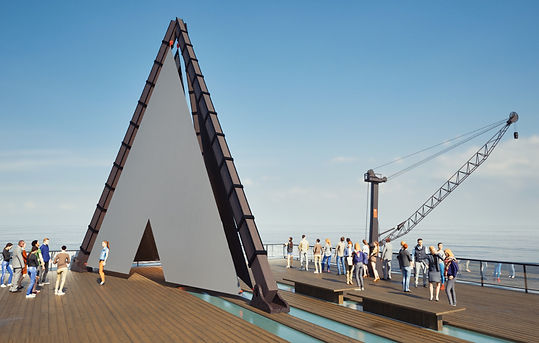
Approach 1 PYRAMIDAL STRUCTURE - Illustration by Giovani Sacrini
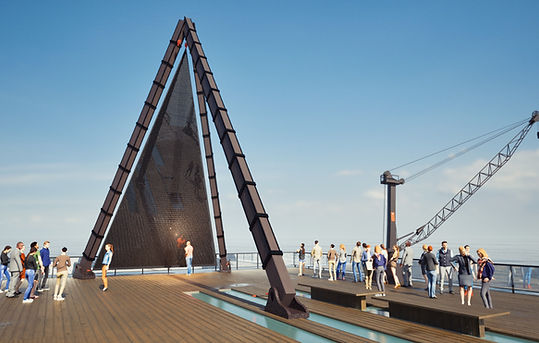
Approach 2 SAIL - Illustration by Giovani Sacrini
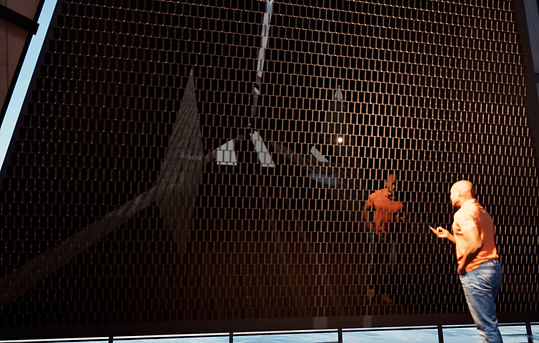
Detail - Illustration by Giovani Sacrini
Credit: Agancia Cafeina vide YouTube
For the main exhibition of the SACO Contemporary Art Biennial, titled "Dark Ecosystems," Paula proposes an installation of “sails” covered on one side by scrap mobile phone screens on the 11.63-meter tall pyramidal structure located at the center of the Melbourne Clark Historic Pier. The SACO Biennial aims to delve into excavations of a renewable wealth: dialogue. Her proposed installation is based on the idea that today, when difficult feelings arise, many turn to their screens. In the social media ecosystem "life" can be controlled, avatars of perfect selves can be created, and contradictory ideas are easily dismissed by leaving groups or blocking challenges. We cling to dark virtual ecosystems in hiding, trying to endure life in the real world like rats and cockroaches cling to their dark ecosystems to survive. Can survival and the development of personal resilience lie not in exploring the dark ecosystems of our screens, but in the dark ecosystems of our internal landscapes? Mobile phone screens serve on a daily basis both as mirrors reflecting our faces on their shiny black surfaces, and portals, offering access to virtual ecosystems. By using discarded materials to create this installation, the artist wants to demonstrate her commitment to environmental responsibility while highlighting the intersection of art and sustainability. The artist proposes two approaches to the installation. The choice between these will be dictated by a joint assessment of suitability to the elements. 1st Approach – Tent-shaped Installation (3 “sails”) The first approach involves installing 3 triangular “sails” made with blackout weather-proof construction canvases, each covered on one side with repurposed mobile phone screens, on the tall pyramidal structure to create a giant tent-shaped, three-dimensional dark space. Visitors can enter to see their reflections on the screens covering the interior of the canvases, excluding the floor. 2nd Approach – Mirror-like Installation (1 “sail”) The second approach involves installing 1 triangular “sail” made with blackout weather-proof construction canvases, covered on one side with repurposed mobile phone screens, roped around the two back pillars of the pyramidal structure to form a giant triangular mirror that leans toward observers below, reflecting their image.

Credit: Saco Bienal de Arte Contemporea
Credit: Saco Bienal de Arte Contemporea
EnTELAçar, 2024
Site-specific original installation project not yet implemented proposed for the Morumbi Chapel in 2025/26 for the Museum of the City of São Paulo composed of 8 objects
Exhibition Hall 2 (Chapel's Nave)
EnTELAçar I | Paula Marcondes de Souza | Brazil, 2024 | Object made with repurposed cell phone screens collected from the garbage and Brazilian castor oil resin on wood | 3.5m x 2m | 105kg
EnTELAçar II | Paula Marcondes de Souza | Brazil, 2024 | Object made with gravel and Brazilian castor oil resin on wood | 2.5m x 1.5m | 75kg
EnTELAçar III | Paula Marcondes de Souza | Brazil, 2024 | Object made with sand and and Brazilian castor oil resin on wood | 2.5m x 1.5m | 75kg
EnTELAçar IV | Paula Marcondes de Souza | Brazil, 2024 | Object made with earth from the State of São Paulo and Brazilian castor oil resin on wood | 2.5m x 1.5m | 75kg
Exhibition Hall 1
EnTELAçar V | Paula Marcondes de Souza | Brazil, 2024 | Object in the shape of sacred heart made with mirror, acrylic, spray and Brazilian castor oil resin on wood | 2m x 1m
MIRROR I | Paula Marcondes de Souza | Brazil, 2024 | Object made with repurposed cell phone screens collected from the garbage attached to a to a truck tarp | 2m x 5m
Exhibition Hall 3
EnTELAçar VI | Paula Marcondes de Souza | Brazil, 2024 | Object made with mirror, acrylic, spray and Brazilian castor oil resin on wood | 2m x 1m
MIRROR II | Paula Marcondes de Souza | Brazil, 2024 | Object made with repurposed cell phone screens collected from the garbage attached to a to a truck tarp | 2m x 2m
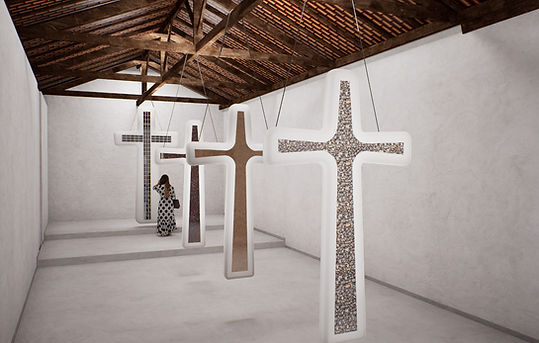
Exhibition Hall 2 (Chapel's Nave) - Illustration by Giovani Sacrini
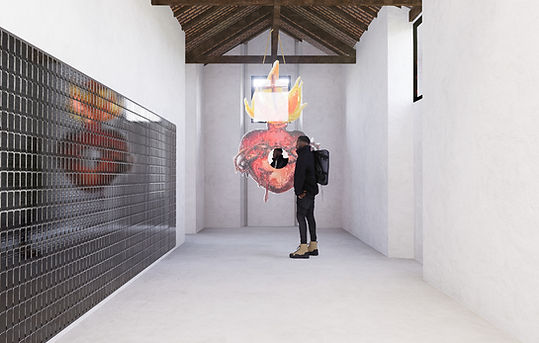
Exhibition Hall 1 - Illustration by Giovani Sacrini
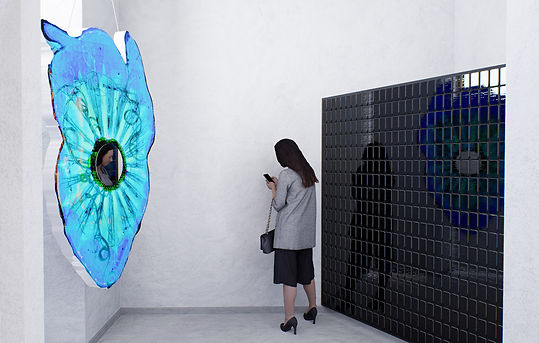
Exhibition Hall 3 - Illustration by Giovani Sacrini
Credit: TV CRECI vide YouTube
For the exhibition at the Morumbi Chapel, the artist proposed the installation of the work “BEscreen” composed of 6 sculptural objects and 3 assemblages, of an ephemeral nature, site-specific, never before seen and developed exclusively for the Morumbi Chapel in the Exhibition Halls 1, 2 and 3. Social Issue Addressed: Data from the latest mapping of depression carried out by the World Health Organization (WHO) indicate that 5.8% of the Brazilian population suffers from depression, the equivalent of 11.7 million Brazilians, indicating that Brazil has the most depressed population in Latin America. Of more concern is the fact that the number of people suffering from common mental illnesses is increasing worldwide, especially in low-income countries. Source: https://g1.globo.com/saude/noticia/2023/11/06/por-que-o-brasil-tem-a-populacao-mais-depressiva-da-america-latina.ghtml Themes addressed by the project: The work BEscreen deals with the topic of mental health, which is of urgent importance and affects the artist directly, since members of her family suffer from depression and other mental illnesses. The work explores ideas about resilience and sustainability on a personal, interpersonal and environmental level, which have been the focus of her life as a teacher and artist. Objectives: The objective of the work is to explore the relationship between virtual ecosystems and ecosystems that exist within and around us, through the interaction of the work with the observer, and at the same time to offer the opportunity to reflect on personal choices that potentially affect resiliency and sustainability at personal, interpersonal and environmental levels. Concept: The work is composed of sculptural objects and assemblages created with reused cell phone screens that the artist collects as trash, and local and sustainable natural materials – gravel, sand and earth – used in taipa de pilão, the technique the ancient walls of the chapel were built with. The reused cell phone screens refer to virtual ecosystems - where there are perfect versions of the Self - which some of us seek to access when escaping from difficult feelings. The gravel, sand and earth refer to real ecosystems that exist within ourselves and in the objective world around us. The observer first encounters cross-shaped sculptural objects made of gravel, sand and earth and, in the chapel’s altar area, finds a cross-shaped sculptural object made of reused cell phone screens that reflect the oberver’s image. This contrast of materials – electronic waste and natural materials – aims to question “deified” choices in the contemporary world and their potential impact on physical, emotional, mental and “spiritual” health. The term “deified” refers to the prevalence with which some fo us insert ourselves into the virtual world through our screens and the importance given to values projected by social media. The term “spiritual” and the shape of a cross (Exhibition Hall 2) and sacred heart (Exhibition Hall 1) have no religious meaning and refer to intrinsic values and personal practices that bring us closer, or not, to states of resilience, sustainability, health and peace both internally and in environmental terms. The term “BEscreen”, that means “to cover with a screen, or as with a screen” and “to shelter; conceal”, refers to the fact that reused cell phone screens serve as portals to virtual ecosystems where our true image and feelings can be concealed, and also as mirrors to reflect the image of the observer. The sculptural objects created with natural materials refer to different aspects of the Self that are intrinsically intertwined: physical, emotional, mental and spiritual. If any of these states of being is not resilient, all other states of being are negatively affected.

Credit: Museu da Cidade de São Paulo
Credit: Museu da Cidade de São Paulo
Going Home, 2023
Paula Marcondes de Souza | Going home | Series Going Home | Installation composed of steel cable, light, photograph Going home I and 300 hand-made metal sculptures in the shape of anatomical hearts | 118” x 394” x 394”| 3m x 10m x 10m
Components:
-
Paula Marcondes de Souza | Going home I | United States, 2023 | Photograph | Pigment on glass | 27” x 16” | 60cm x 40cm
-
Paula Marcondes de Souza | Going Home II – CCC | Brazil, 2023 | 300 hand-made sculptures made with rusty repurposed wire | Approximately 10” x 8” | 25cm x 20cm each

Sketch

Component: Paula Marcondes de Souza | Going home I | Series Going Home | United States, 2023 | Photograph| Pigment on glass | 27” x 16” | 60cm x 40cm
-fotor-2024041719328.png)
Component: Paula Marcondes de Souza | Going home II | Series Going Home | Brazil 2023 | Metal sculpture | 10” x 8” | 25cm x 20cm
-fotor-2024041719149.png)
Component: Paula Marcondes de Souza | Going home III | Series Going Home | Brazil, 2023 | Metal sculpture | 9” x 7” | 23cm x 18cm


